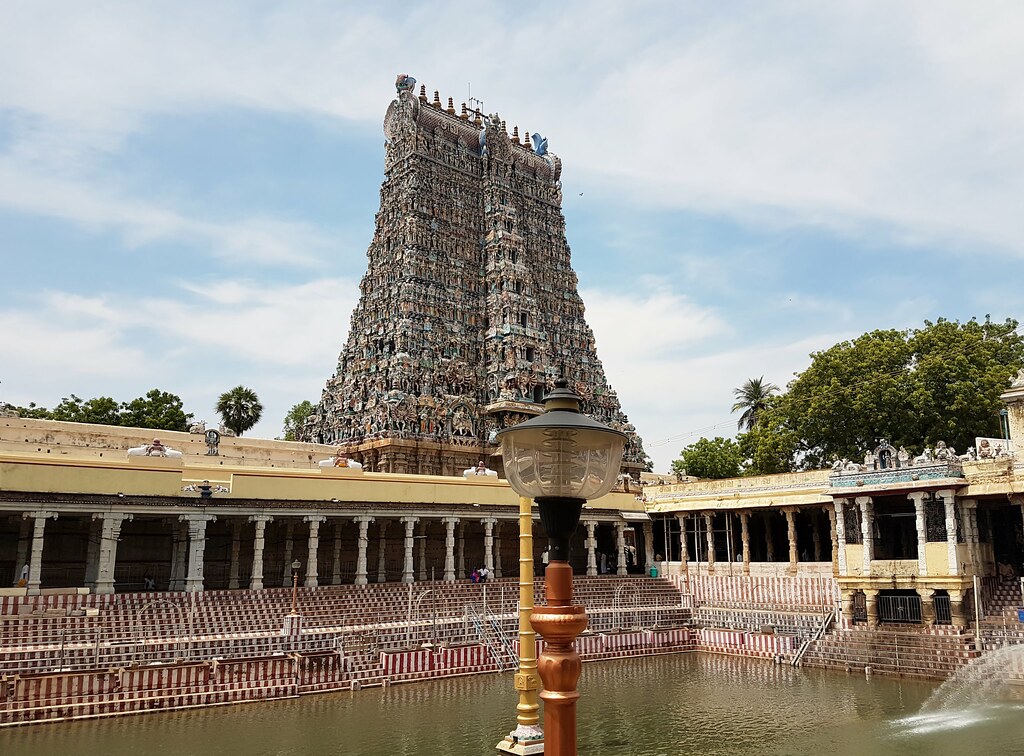The Meenakshi Temple is a Hindu temple complex located in the city of Madurai in the Tamil Nadu state of India. The complex is dedicated to the goddess Meenakshi (considered a manifestation of the goddess Parvati) and her consort Sundareshwara ("The Beautiful God" – a form of the god Shiva).
Location and General Features
The Meenakshi Temple is located in the city of Madurai in the Tamil Nadu state of South India. Currently, this temple complex, covering an area of approximately 67,000 square meters, receives approximately 20,000 visitors daily. The complex is surrounded by high walls and gateways, creating a collection of indoor and outdoor spaces where small and cramped shrines, spacious halls, low and high ceilings, dark and bright spaces, and hustle and bustle and silence coexist. It is reported to contain approximately 30,000 statues in total.

Meenakshi Temple ( Flickr )
History and Architecture
The oldest temple in Madurai is thought to have been built in the 7th century AD. However, the temple complex seen today is the work of the Nayak dynasty in the 16th and 17th centuries. This dynasty expanded the complex and redesigned the surrounding streets in accordance with the sacred tradition of Vastu Shastra (Hindu texts that specify form, proportion, size, ground plan, and architectural layout). The Meenakshi Temple is an example of Dravidian architecture , a Hindu architectural style common in the southern states of India. Typical features of Dravidian architecture include covered verandas in temples, high gate towers ( gopuras ) on two or more sides , multi-pillared halls, and a water tank or reservoir for ritual bathing.
Mythological Origin
Many sacred sites in India, such as the Meenakshi Temple, have mythological origins. According to tradition, over 3,500 years ago, the god Indra built a small tower on a naturally formed stone lingam to show his devotion to Shiva, one of the principal Hindu deities . Other deities also began worshipping there. Later, a human devotee witnessed the scene and reported it to the local king, Kulashekhara Pandya. The king built a temple on the site.
The story of the Meenakshi figure, for whom the temple is named, goes like this: King Malayadhvaja, hoping for a son and heir, was granted a daughter by the gods; this daughter, Meenakshi, was born with three breasts. The gods prophesied that Meenakshi would be raised as a warrior and that her third breast would disappear when she met her true love. When Meenakshi met Shiva, the prophecy came true, and one of her breasts fell off. Shiva and Meenakshi were married in a wedding presided over by Vishnu, and they reigned (and symbolically continue to reign) as queen and king over Madurai.

Old Image of Meenakshi Temple ( Look and Learn )
Parts of the Temple Complex
At the center of the temple complex are two main shrines, accessible only to Hindus: one dedicated to Meenakshi , considered a manifestation of the goddess Parvati , and the other to Sundareshwara ("Beautiful God"), a form of the god Shiva. Each of these shrines is topped by a golden crown visible from a high vantage point. In front of each shrine is a mandapa (a porch-like structure with columns), through which pilgrims pass on their way to the garbagriha (the innermost sanctum of the sanctum ). At the south end of the complex is the Golden Lily Tank , used by believers for ritual bathing before entering the sanctum . In the northeast corner of the complex is the Hall of a Thousand Pillars , a vast mandapa . Although it actually contains 985 columns, most of these columns are carved in high or low relief, depicting gods, demons, and divine animals.
Originally used as a place for religious dance and music performances and as a meeting place with the king, the hall now functions as a museum displaying bronze statues, paintings and objects from the temple's history.
Gopuras
The complex is characterized by massive towers, or gopuras, which are essentially gateways . Fourteen gopuras , roughly oriented along the cardinal points, surround the Meenakshi or Sundareshwara temple, or the entire walled area . The gopuras generally increase in height as they move away from the center of the complex. These towers serve as symbolic markers of the sacred precincts they enclose. Most gopuras are covered with brightly painted stucco figures representing gods and demons. The tallest gopura is approximately 51 meters tall and contains over 1,500 figures, which are repaired and repainted every twelve years. The figures of gods and goddesses on the gopuras are repeated as they ascend to the heavens, as if reborn repeatedly, symbolically preventing the pollutants of the everyday world from polluting the sacred spaces within.
Spiritual and Worldly Life
The Meenakshi Temple is in many ways a reflection of the secular and spiritual characteristics of Hindu India; it is bustling, crowded, and filled with people from all walks of life. Like many Hindu temples, the Meenakshi complex contains numerous small shops selling offerings of fruit and flowers, guidebooks, small votive statues, jewelry, souvenir T-shirts, and other souvenirs. The temple's shrines, pillars, statues, and images are filled with divine beings engaged in various activities, capable of manifesting in multiple forms and locations simultaneously, and subject to destruction and rebirth. Every Friday evening, statues of Meenakshi and Sundareshwara are placed on a swing in the temple and gently swayed, and each spring, they are celebrated in a daily festival.


